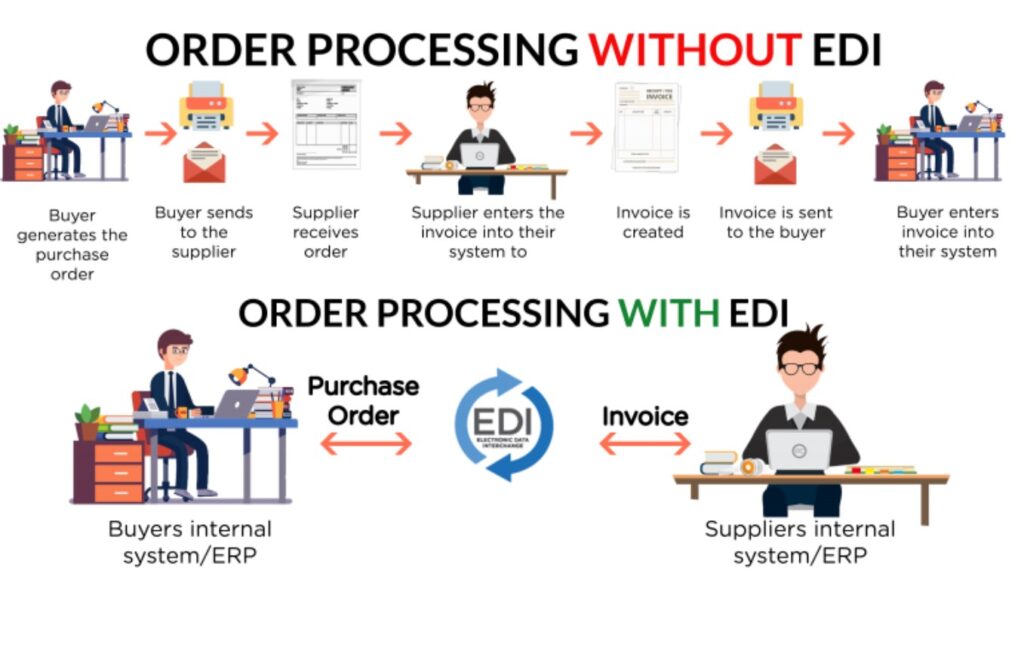Electronic Data Interchange (EDI) technology has helped many businesses maximize their data usage and exchange. However, still, a lot of them make use of their existing legacy systems to process B2B transactions. Traditional B2B transactions such as sales order, invoice, purchase order, functional acknowledgement are lengthy and complex. Meaning, they not only include a series of steps to process but also they are tedious and time-consuming. Moreover, processing these transactions require a lot of human intervention that makes them prone to errors and discrepancies. But, using technologies such as EDI can help companies’ process data without any manual intervention.

What is EDI?
Electronic Data Interchange (EDI) involves a virtual exchange of data or a set of business documents between distinct trading partners in electronic format. This electronic exchange between documents happens between buyer and supplier. The documents transferred include orders, shipping notices, invoices, and more. Since EDI technology relies on automation, companies can improve operational efficiency and streamline data exchange.

Why EDI Integration?
Currently, the hyper-digital business world is dependent on EDI to streamline their business transactions. However, those who are aware of how to use to its fullest potential are the ones who can reap dividends via modern EDI integration solutions such as Adeptia Connect. Let us find how EDI integration software works?
EDI integration software allows companies to have an integrated approach that can deliver operational visibility, automated workflows, and improved customer service. EDI integration involves the following steps:
Step 1: Sender transfers document like purchase order from an application or an in-house system.
Step 2: Purchase order is converted into the required EDI format by using techniques such as data transformation mapping or any other EDI translators.
Step 3: EDI document is allowed to run through a processing software that ensures structural accuracy.
Step 4: The data that resides in the EDI document is either transmitted to a particular Value-added network using protocols such as SFTP, HTTPS, or AS2.
Step 5: Direct EDI over AS2 forms a safe line that allows companies connect to their trading partners without any additional fees. The receiver on getting the file verifies and authenticates it, and decrypts it to make it available for data ingestion. The receiver also sends a message back to acknowledge the delivery.

What are the Benefits of EDI Integration?
EDI integration solutions offer many benefits, from streamlining business data exchange to increase information accuracy. Let’s delve into the benefits in detail.
Operational Automation: It automates operations and transfer of mission-critical documents. This, as a result, allows companies to maximize their data usage and thus improve decision-making. Automation of business operations not only makes the process faster but also accurate and simple.
Speed: EDI integration helps companies reduce processing time as it is an automated process. This increases the speed of business cycles to a great extent. Order-to-shipment cycles can be cut down by almost 50 to 60%, and so the data that once took days or weeks for exchange now takes only minutes to get processed.
Accuracy: Errors or discrepancies disturb data flow and management. EDI integration can help avoid making such errors, thus increasing accuracy. When companies use manual methods to enter data into an ERP system, mistakes are bound to occur, according to twm.com.sg. Automated solutions such as EDI, on the other hand, automate cumbersome processes and eliminate the risks of errors introduced through manual intervention.
Efficiency: Proven to be fast and highly accurate, EDI integration software improves the operational efficiency of business processes. Companies need not rely on hands-on processing methods to carry out operations, and so their relationships with their customers improve substantially. Not to mention, the occurrence of errors reduces and delivers the speed of goods, as well as services, expedites.
Security: Enterprises with an EDI model in place are generally considered safer and secure as their counterparts. As a matter of fact, EDI integration solutions ensure security and gives access to only authorized personnel with tracking and audit trail capabilities. In addition, they can share data across business ecosystems over many communication protocols and standards to ensure compliance with mandates in global business.

Get Started with a Modern EDI Integration Solution
Now, that we are aware of the importance and benefits of EDI integration technology, it’s time to choose the one that meets your expectation and demands. One needs to pay heed to their requirements and keep the end goal in mind before making the selection as their choice will decide whether the business flourishes or perishes.










